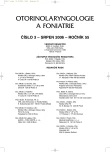Biopsie sentinelových uzlin u nádorů hlavy a krku
Biopsy of Sentinel Nodes in Head and Neck Carcinomas
Objectives:
A prospective study was performed to test the efficacy and reliability of sentinel lymph node biopsy (SLNB) in head and neck carcinomas.
Methods:
Forty N0 staged patients were enrolled, with tumours in following sites: oral base and/or tongue (16x), parotid gland (8x), tonsill (7x), larynx, soft palate, retromolar triangle (2 each), mandibular alveolus, external acoustic meatus and nasal septum (1 each). The histopathological spectrum of the lesions consisted of squamous cell (32x), salivary duct and myoepithelial carcinoma and mucosal melanoma (2 each), adenocarcinoma and mucoepidermoid carcinoma. In each patient, a 99mTc nanocolloid lymphoscintigraphy, followed by exstirpation of the primary and neck dissection, associated with gamma probe sentinel node identification, was performed. The histopathological status of particular sentinel nodes was compared to that of the lymphadenectomy specimen, using routine H.E. stain and immunohistochemistry (monoclonal cytokeratin antibodies AE1, AE3 na carcinomas, HMB-45 in melanomas).
Results:
By the lymphoscintigraphy and gamma probe, the sentinel nodes were identified in 38/40 and 37/38 of patients, respectively. Altogether, in 37 patients 580 non-sentinel and 114 sentinel nodes were removed and evaluated. In 5 cases of 8 cases, in which the sentinel node was positive, the lymphadenectomy specimen also harbored metastatic foci. In 27/29 patients with sentinel node negativity, the lymphatic basin was found free of metastases, which were present in the reamaining two 2 cases. The false negativity of the SLNB of the latter was caused by methodical errors at the beginning of the study. In the statistic evaluation a 71.4% sensitivity, 90% specificity, 93.1% negative and 62.5% positive predictivity was reached.
Conclusions:
SLNB is a reliable method for identification of occult nodal disease in those head and neck carcinomas which are amenable to a direct application of the radiopharmaceuticals, first of all in tumors of oral and anterior nasal cavity, oropharynx and supraglottic region. We do not recommend the method in the sites, where the tracer can not be safely applied at the tumor periphery. SLNB is also applicable in parotid gland cancer, but in this case we must take into account the histopathological status of intraparotid sentinel nodes, which, going undetected both by lymphoscintigraphy and gamma probe, are the integral part of the parotidectomy specimen. The value of SLNB in mucosal melanoma, because of its biological vagarity, is obscure.
Key words:
elective lymph node dissection, gamma probe, head and neck cancer, intraoperative lymphatic mapping, lymphoscintigraphy, sentinel lymph node.
Autoři:
I. Stárek 1; P. Koranda 2; L. Mrzena 3; J. Betka 3; L. Kučerová 4
Působiště autorů:
Klinika ORL a chirurgie hlavy a krku LF UP a FN, Olomouc
; přednosta prof. MUDr. I. Stárek, CSc.
Klinika nukleární medicíny LF UP a FN, Olomouc
1; přednosta doc. MUDr. M. Mysliveček, CSc.
Klinika ORL a chirurgie hlavy a krku 1. LF UK a FN Motol, Praha
2; přednosta prof. MUDr. J. Betka, DrSc.
Ústav patologické anatomie, FN, Olomouc
3; přednosta doc. MUDr. M. Tichý, CSc.
4
Vyšlo v časopise:
Otorinolaryngol Foniatr, 55, 2006, No. 3, pp. 150-160.
Kategorie:
Původní práce
Souhrn
Cíle:
Zhodnotit možnosti a spolehlivost radionavigované biopsie sentinelových uzlin u ORL nádorů.
Metody:
U N0 nemocných s tumory cest dýchacích a polykacích (32x) a gl. parotis (8x) byla nejdříve provedena lymfoscintigrafie 99mTc koloidním albuminem. Následovala exstirpace primárního tumoru a elektivní bloková disekce s identifikací aktivních uzlin. Histopatologický stav sentinelových i nesentinelových uzlin byl hodnocen vyšetřením H. E. a imunohistochemicky.
Výsledky:
Lymfoscintigraficky jsme identifikovali sentinelovou uzlinu u 38/40 pacientů, gama sondou u 37/38 pacientů. Celkem bylo odstraněno 580 nesentinelových a 114 sentinelových uzlin. U 8 nemocných byla sentinelová uzlina pozitivní, z toho u 5 jsme nalezli metastázu i v ostatních uzlinách. Ze 29 případů s negativní sentinelovou uzlinou byl histopatologický nález v blokové disekci 27x negativní a 2x pozitivní. Dosáhli jsme 71,4% senzitivity, 90% specificity, 93,1% negativní a 62,5% pozitivní prediktivity.
Závěry:
Metoda je vhodná k identifikaci okultních metastáz v oblasti hlavy a krku u tumorů, dostupných přímé aplikaci radiofarmaka.
Klíčová slova:
elektivní krční disekce, peroperační gamasonda, karcinom hlavy a krku, peroperační mapování lymfatického systému, lymfoscintigrafie, sentinelová uzlina.
Štítky
Audiologie a foniatrie Dětská otorinolaryngologie OtorinolaryngologieČlánek vyšel v časopise
Otorinolaryngologie a foniatrie

2006 Číslo 3
- Isoprinosin je bezpečný a účinný v léčbě pacientů s akutní respirační virovou infekcí
- Fexofenadin – nesedativní a imunomodulační antihistaminikum v léčbě alergických projevů
- Pacienti s infekcemi HPV a EBV a možnosti léčebné intervence pomocí inosin pranobexu
- HPV v dýchacích cestách a papilomatóza hrtanu
- Klinický obraz cytomegalové infekce
Nejčtenější v tomto čísle
- Zúžení hrtanu a průdušnice u dětí
- Standardní a punkční dilatační tracheostomie Porovnání výsledků a komplikací
- Má význam hodnotit velikost adenoidních vegetací?
- Srovnání účinnosti analgetik u pacientů po tonzilektomii
